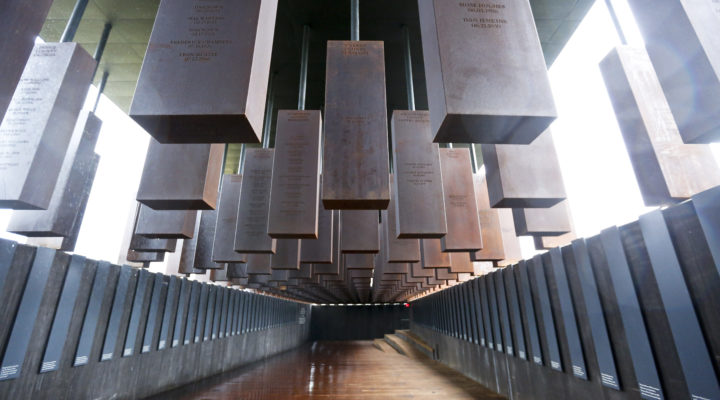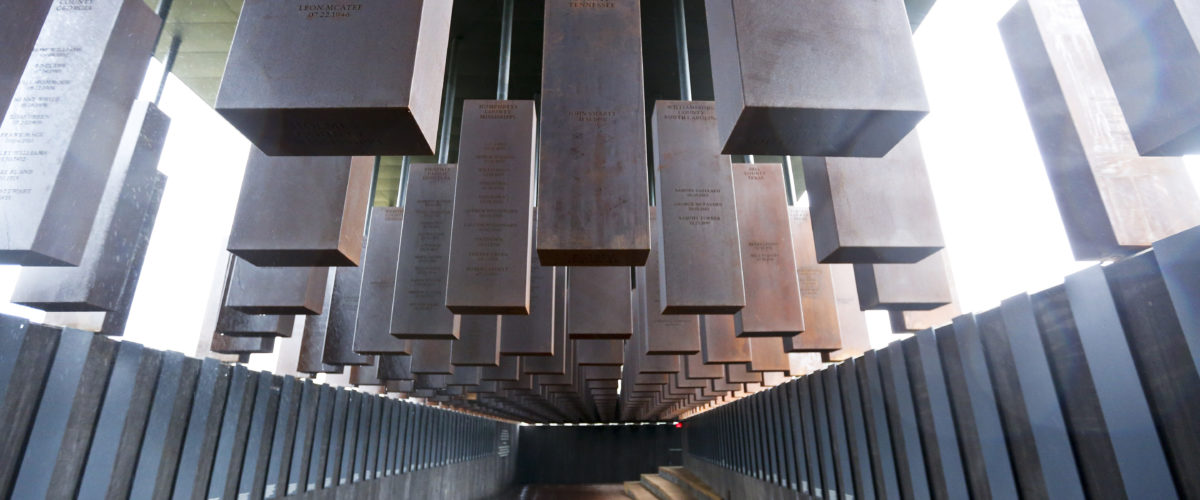Lynching is a part of America’s past that must be confronted and accepted before racial healing can occur, says Hannah McMahan, executive director of the New Baptist Covenant.
“It’s so important that people in our communities acknowledge this part of our history,” McMahan said moments after attending today’s formal opening of the National Memorial for Peace and Justice in Montgomery, Ala.

Hannah McMahan at the National Museum for Peace and Justice.
The complex includes a Lynching Memorial with 800 steel monuments, one for each of the U.S. counties where a lynching occurred. Each monument contains the name of every person lynched in that county.
More than 4,400 people were lynched from 1877 to 1950, the Equal Justice Initiative said on the museum website.
McMahan said it was overwhelming to be visually presented with all those murders — especially because the killers often were people of faith.
“We hide from this part of our history,” she said. “But facing this part of our history is going to heal us from our blindness. I see it as a pilgrimage for white Christians.”
McMahan spoke with Baptist News Global after attending the opening ceremonies. Here are her comments, edited for clarity.
What are your thoughts as you drive away from that event?
Well, for a long time, lynching has been hidden in the background of our history. We know about the Civil War and we know about civil rights, but the racialized terror of lynching is often overlooked. The Equal Justice Initiative is important because it is showing that racialized terror happened and is part of our history. When we turn a blind eye to that history, we really are trapping ourselves, imprisoning ourselves, in a false narrative. None of us can get to the beloved community — authentic reconciliation — until we can own what we are carrying on that journey.
Do lynchings still occur, only in different forms?
Yes. There are methods of social control we still see. One of the speakers spoke very movingly about lynching as a message to the African-American community to stay in their place, that their lives could be snatched up at any moment and they better not step out of line. The way we see the African-American victims of police shootings, and the way they are treated and processed in our courts today, sends a message to others in the African-American community that they are not equal in the eyes of the law and we still live in an unjust society where their lives are not valued the same as white lives.
Was the experience in any way too much to handle?
You get a sense of the magnitude of what’s being talked about and that lynching was just the extra-legal punishment outside the courts. Some were lynched by being burned alive. The most common was being hanged. Lynching took many different forms. The number of pillars there just takes your breath away. They go on and on with each one representing at least one person who was brutally and unjustly murdered because of the color of their skin. That is devastating, humbling and moving. But what the Equal Justice Initiative is really doing there is providing dignity to these lives that were so casually cast aside.
They also have a museum in conjunction with the memorial. In the museum, they honor the tenacity of the human spirit. Because even in the brutal context of slavery you had enslaved people who were artists, who were singers and creators and engineers who have built this country. They are lifting up the people who were lynched and the people who were enslaved.
Will what you saw and heard today influence your ongoing work for racial reconciliation?
One of the books that has most shaped my life is The Cross and the Lynching Tree. In lynching culture you would have communities of Christians both drawing on the story of the Cross. African Americans looked at Jesus on the Cross and saw that Jesus had come into an unjust world and suffered just as they did. And you would have white Christians who believed a contamination of society, which is how they saw African Americans stepping outside white-prescribed roles, required a blood sacrifice. I don’t know what takes God’s name in vain more than taking our most sacred story to justify racial terror.
When I do the work that I do, part of the texture is recognizing the way that white women have been complicit in a culture of racialized terror and have been willing to trade justice for a step up the ladder. So that to me is something that still is heavy. At the same time, the way power structures work is to pit non-dominant groups against each other.
How can the museum and the memorial help Americans live into the future?
We cannot be free until we own our history. The path of salvation always begins with confession and repentance and then turning to justice and so that can be the starting point. But one the things that is so inspiring there is going back and lifting up the brilliance of enslaved people and lynched people.
In this brutalized context the tenacity of the human spirit and the spark of the divine that is there in enslaved people and in those who were lynched gives us models of faith and of what real tenacity looks like what real genius looks like and what real courage looks like.


